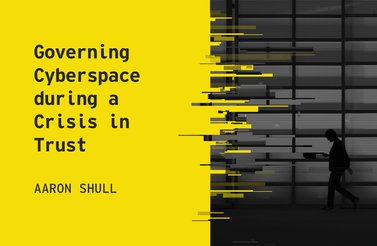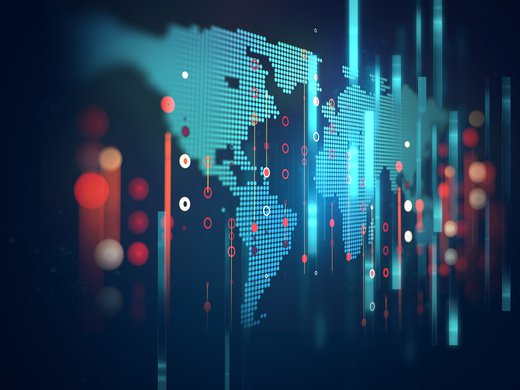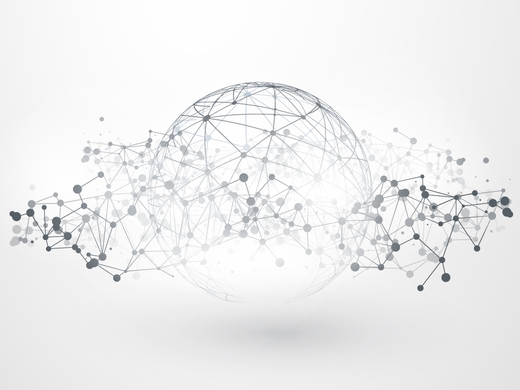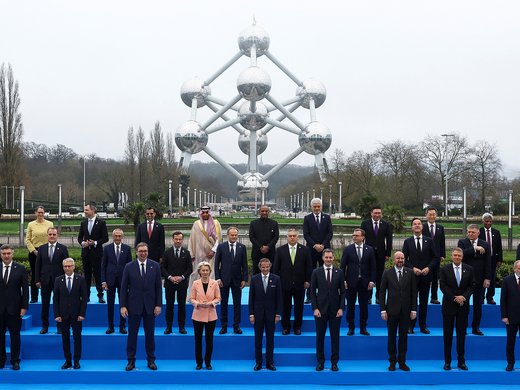In 2017, reflecting on his original proposal for the World Wide Web, Tim Berners-Lee wrote in The Guardian that he imagined the internet as “an open platform that would allow everyone, everywhere to share information, access opportunities, and collaborate across geographic and cultural boundaries.”
But today, 30 years on from the invention of the web, the ideas of openness, transparency and universal access that underpinned Berners-Lee’s founding vision are under threat. What’s more, as the University of Southampton’s Wendy Hall and Kieron O’Hara explain, the traditional model of the open internet — a given in Silicon Valley — is being challenged by various alternatives, some of which are backed by major geopolitical players.
Hall, the university’s Regius Professor of Computer Science, and O’Hara, an associate professor in electronics and computer science, have worked together in the United Kingdom for years. Their research outlining the four visions of the internet that they consider to be influential right now was published in a recent Centre for International Governance Innovation report, Four Internets: The Geopolitics of Digital Governance.
With more than four billion internet users globally, questions about which version of the internet might prevail will only become more urgent in the coming months and years. In this written interview with CIGI, Hall and O’Hara jointly discuss how geopolitics play into the competing visions, what’s at stake as more and more people come online, and what internet governance might look like in the future.
Can you provide a brief explanation of each of the “four internets”?
Each of the four internets we talk about is motivated by a particular vision of how human interaction should be facilitated and regulated. These visions translate into an idea of what the internet should do, and how it should do it.
The first to appear, historically, is the Open Internet. This idea is particularly associated with the libertarian techies of Silicon Valley in California, and it basically says information should flow without friction, totally freely (or at least with minimal restrictions). It has two parallel justifications. First of all, there is the political view that free speech is a prime value — particularly in the United States, where it is enshrined in the First Amendment to the Constitution dating back to 1791. But this is backed up by an engineering justification, that the packets of data whizzing round the internet will travel most efficiently when there are minimal restrictions on how and where they travel. In other words, if we treat all messages as though they had equivalent value, independent of their content, they will reach their destinations most quickly.
The other visions of how the internet should work are basically reactive to this Open Internet vision. One response is to worry about the damage that freely flowing information causes. For instance, privacy may be compromised; offensive, racist or pornographic content could proliferate; or fake news could damage trust in institutions. This response tries to preserve freedoms, while preventing social harms as far as possible. This vision of the internet is premised on the idea of everyone behaving well within a set of well-understood social conventions, and with social protections. It’s a European view of the internet, and we see its influence particularly in regulations such as the General Data Protection Regulation (GDPR), or earlier judgments such as when a French court fined Yahoo! for selling Nazi memorabilia in an international online auction. We call this the Brussels Bourgeois Internet.
A second response to the Silicon Valley Open Internet is to view the internet as private property, and look to markets to decide what should happen. So, for instance, if someone wanted to restrict the flow of information in or out of their domain, that is their business. If someone wanted to charge extra to allow faster or more efficient distribution of information through channels under their control (e.g., to ensure that expensive video travels more quickly than email, which is less time-dependent), that is their business. In this view, allowing people to monetize their investments will lead to more and better innovation. This property-oriented vision is pushed for in Washington, DC, particularly in many judgments of the Supreme Court. Governments come and go, but the Supreme Court has been particularly consistent. This is the DC Commercial Internet.
Where someone has a strong view of social order and how society should be arranged, a third response is to argue that the internet should be subservient to a particular set of social values, or a national or group interest. This is therefore the fourth internet, the Paternal Internet, where authority is used to create particular outcomes and to close other options down. Supporters of the Paternal Internet see the internet’s surveillant tendencies as an opportunity to steer, nudge or even coerce a population into performing or refraining from particular actions. This is an area which has probably been theorized and pursued most extensively in China, so we dub it the Beijing Paternal Internet.
Each internet vision seems to be associated with a world power or region. Are things so neat in real life?
Certainly not so neat; nothing real ever is. These geopolitical labels are intended to animate the more abstract ideas (and of course only one of the labels refers to a nation state). They are caricatures, but not inaccurate ones — you will find more advocacy of openness in Silicon Valley, more social concern in Brussels and Europe, and so on. But all nations are attracted by a measure of each of these. Governments aren’t single actors, they are a tangle of different interests and incentives. So a government’s health service might prefer the Beijing model as a means of nudging people to exercise more, and its interior ministry might look to its security and policing advantages; its data protection regulator might like the Brussels model to preserve privacy; its treasury might favour the DC model to promote innovation and business, while a lively media might prefer the Silicon Valley model. The balance between those actors is different in different polities. Israel, for instance, has a lively tech scene and of course highly controversial politics — a combustible mix. Like all generalizations, our sketch apparently conceals this complexity, but by bringing out the different visions, we hope to provide the means for describing the balance of interests more accurately.
Can you tell us about the Moscow Mule Spoiler Model you mention in your paper?
Another response to the engineering of the internet is to hack it, to use its engineering against itself. It’s engineered to facilitate the flow of information — the engineering is neutral as to whether the information flowing is valuable or harmful, true or false. So fake news, malware and trolling are in some sense the use of the internet’s power against itself, judo-style. Again, all governments indulge in misinformation, cyberespionage and even cyberwarfare. However, we locate the main epicentre of thinking in this space in Russia, where President Vladimir Putin’s brand of mystical nationalism, inspired by the philosopher Ivan Ilyin, mandates aggressive manipulation of the information space of its perceived enemies. So we call this the Moscow Mule Spoiler Model. We find it everywhere, and some countries, such as Iran, make a specialty of this kind of work. This isn’t the extent of Russian internet policy — remember what we said earlier about governments being a tangle of actors — but Russia is the world leader.
This vision doesn’t constitute a fifth internet, because it doesn’t suggest a particular form, function or architecture to build. It’s not constructive in that way. It asks only that there is an internet, of one form or another, to subvert. To that extent, it is parasitic on the efforts of those building and governing the internet in good faith.
What are some examples of instances where these visions have clashed?
There are plenty. There is the battle over net neutrality that is largely, but not exclusively, in the United States, where the Silicon Valley model advocates free flow of information packets through the internet hardware, and the DC model upholds infrastructure owners’ rights to, for example, speed some packets through for a payment. We can see the efforts of the European Union’s courts to apply GDPR in contexts beyond Europe as an attempt to spread the Brussels Bourgeois model into the wider world. The Facebook initiatives Internet.org and Free Basics — both of which intended to bring affordable internet access to less-developed nations — were attempts to create a walled garden on the DC model to countries that had their own view of the national interest, and so may have preferred a more Beijing-style Paternal Internet or one of the other models, which led to charges of “digital colonialism.” Russian attempts to spread fake news and interfere with the conduct of elections in the United States, Germany, the United Kingdom and elsewhere are clashes between the Moscow Spoiler Model and the alternatives. The current argument raging about whether Huawei is enabling Chinese surveillance is an argument about whether the Chinese government is pursuing the Moscow Spoiler model, using Huawei as an agent, or not. Wikileaks stands for Silicon Valley openness without compromise; it is therefore directly opposed by the Brussels, DC and Beijing models (for perhaps different reasons), and has at times become a tool of the Moscow Spoilers.
“Tech giants speak fluent Silicon Valley when they want to promote the free flow of information, adopt the DC model when they want to protect their business models or stop data from leaving their walled gardens, and even pay lip service to Brussels when they work to salvage their reputations by embracing GDPR.”
You even see clashes within organizations: the tech giants speak fluent Silicon Valley when they want to promote the free flow of information, adopt the DC model when they want to protect their business models or stop data from leaving their walled gardens, and even pay lip service to Brussels when they work to salvage their reputations by embracing GDPR.
You write in your paper that it might be time to revisit some of the assumptions underlying the internet’s design. Can you remind us of these assumptions?
What we really challenge is the idea that there is a “neutral” or “value-free” set of ideas about how the internet should be run. For instance, engineers often assume that frictionless information flow is value-neutral — it’s not. It is itself a value — not a bad value, but a value nonetheless. Similarly, the internet is run by several different organizations, in what is called a multi-stakeholder model. Do we know that the right stakeholders are at the table? Do we need more diversity? Or maybe more centralization? In particular, the United States has played an outsize part in the development and sustenance of the internet. That has to be revisited, given the shift to a multipolar world, but there is potential for disaster, as the United States has proved to be an admirable steward of the internet. It is impossible to imagine the internet being as successful as it has been without the powerful presence of the United States pushing it forward and protecting it. Basically, we need to make sure internet governance isn’t captured by a small set of interests (we talk about the World WideWeb, after all), without ceding too much power to bad actors, dictators, short-termists, hegemons or engineering incompetents.
As a third example, related to the last one, the internet’s standards are open, but not developed by an open community; do we need to rethink that? It’s probably always a good time to revisit these assumptions. But now seems propitious. A little over half the world’s population is now online to some extent. The internet’s growth is going to take place in much of China (where internet penetration is still less than 60 percent), India (35 percent) and Africa (under 25 percent). In other words, the developed democracies (with the exception of the United States, where penetration is still only about 75 percent) are pretty well done and dusted, so the geopolitical conditions for the further growth of the internet will change dramatically.
What will happen when the three billion people in the world yet to come online do so?
We don’t know what will happen. Without wishing to make this sound like a sporting contest, there is all to play for. Clearly, China has worked hard to establish contacts in Africa, for instance. It is less popular in India, although its big tech companies are investing a lot there. Under President Donald Trump, the United States is now less interested in projecting its values worldwide, but the big tech companies will always be interested in expanding their networks, which are the sources of their immense value.
India will certainly be one of the key areas. One particular, absolutely crucial development is the Aadhaar initiative, the world’s largest biometric ID system, in which over a billion people are enrolled, an incredible social and technical achievement. In a country with many remote rural areas, many people without recourse to banking and other routes into the formal economy, and a fair amount of corruption, Aadhaar provides means for ensuring benefits go to their intended recipients, that people can receive loans, prove their entitlement to land, and so on. Clearly immensely valuable for development. However, if India goes down the Beijing route (which it may, with recently re-elected Prime Minister Narendra Modi currently running on a strongly nationalist platform), Aadhaar could easily become an important tool for social control. Aadhaar is currently under scrutiny from India’s courts, but even if its use hits legal limits, it may still provide a blueprint for other developing nations to create ID systems from scratch.
How should the various internets you outline be governed going forward? What does the splintering of the internet mean for larger questions around data governance?
The main thing is to keep a single connected entity which is the internet, a single network of networks. We have to accept that many of these networks within the global network will be governed locally with divergent principles. The United States may have to accept that its principles of freedom of speech and association are not going to be acceptable worldwide, and it may need to accept rights to censorship. The European Union may have to accept restrictions on the privacy of its citizens abroad. China may have to turn a blind eye to activities of its citizens abroad. Everyone should recognize the need to stand together against hacking and undermining the quality of information. It’s no good cheering a hack of one political party because you lead the other; if parties can be hacked at will, then your party is just as liable to be on the receiving end at the next election. One might gain in the short term from electoral manipulation, but we all lose in the long term.
What does it mean? The emergence of these different visions (and others may follow) puts pressure on what has been a relatively cozy group of like-minded, well-meaning engineers who have jointly created what is, after all, an astoundingly successful piece of technology, on any measure. But this success should not be taken as meaning we can carry on as we have been. We need to realize that more traditions and cultures need to be involved, far greater diversity of gender, ethnicity, age and so on. Internet governance needs to adapt to the presence at the table of legitimate, well-intentioned but undemocratic and possibly even dictatorial governments, to create and maintain infrastructure that keeps our four (and possibly more) internets connected.
We also have to remember that the internet is a piece of technology, yes, but one that is meaningless without the three or four billion people sending information across it. Technologies aren’t created and imposed on passive populations; they are adapted, twisted and co-opted by all of us. Technologies are co-creations of engineers and users — each user is his or her own engineer, if you like. If internet governance fails to recognize that, then the internet will become very brittle indeed.
In your opinion, what will the internet look like in 50 years? In 100? Will one vision be dominant? Or will it look nothing like the “four internets” of today?
The co-creation point means that prediction is a mug’s game. Let’s go further — 50 years is not far off the whole history of the internet, and who would have predicted this in 1969? Even the first imprecise mentions of cyberspace were in the 80s. And our story has always been a story of unintended consequences.
What we can say is that the worth of networked digital technology has been proved over and again, so it’s hard to imagine that there won’t be something that looks like, and is probably descended from, the internet we know and sometimes love. There may be many systems, or one. We may be looking at an interplanetary internet, or the Internet of Things may routinely incorporate human bodies and/or brains. Maybe data processing could become the major threat to the environment and climate change; maybe a post-Moore’s Law internet would have to face difficult trade-offs about carbon emissions.
Will the same four internets, plus the spoiler, still be around? Quite possibly, as they are fairly predictable responses to technological challenges. They may have been joined by others. It’s also possible that one becomes dominant (possibly temporarily), and we wouldn’t like to predict which one. A single dominant is probably not sustainable, and probably not desirable, if we are to have a global system of communication, where anyone can talk, more or less, to anyone. The shape of digital modernity is still up for grabs, and we are nowhere near the endgame.





